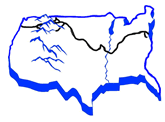Lewis and Clark barter with the Native Americans


Using the study of the Lewis and Clark expedition students will define the term barter and give examples of bartering.
Introduction
To begin the lesson, have each individual student define barter. To help you learn about the term barter check out this Popup Activity
(Use the example of Lewis and Clark bartering with Native Americans as a jumping off point to help the students understand barter economics better.)
Have the student list examples of bartering in today's society. Examples: trading food in the cafeteria with your neighbor, exchanging video games with your friends, giving someone a ride home in exchange for an ice cream cone, trading a book you have read or a movie you have watched with a friend for one you haven't, mowing your neighbors' lawn so they will plow your walk and driveway in the winter.
Ask the students to think about a long and difficult trip that they once experienced. Have them think of what kind of materials that they took on this trip. Keeping these things in mind, have the students discuss with a neighbor what they would take with them on such a trip.
Learning Objectives
-
 Define the term barter and give examples of bartering in the following areas:
Define the term barter and give examples of bartering in the following areas:
- The nation and Thomas Jefferson's interest in an exploration of trade routes to the pacific northwest as part of the westward expansion of the country.
- The mission of discovery and the need to practice trade to survive.
- The native peoples who expected mutual benefit.
[NOTE: Students will also be able to identify cases where property rights meant the difference between life and death. As well as identify the significance of trust in making deals and recognize the amount of time required to establish terms of trade.]
Resource List
The following are Lewis and Clark web sites:
-
Activated Travel Map: This web site is used to complete Activity 1. This site documents Lewis and Clark's journey from St. Louis to Oregon and back home. The site also highlights key stopping points where the expedition group created forts.
www.staff.washington.edu/muzi/LC/LCmap.html
-
To Equip an Expedition: This web site is used to complete Activity 2. It gives great examples of what supplies the explorers took with them on the journey and a little background on Lewis's preparation.
www.pbs.org/lewisandclark/inside/idx_equ.html
-
The Journals of Lewis and Clark: This web site is used to complete Activity 3. This site gives great examples of transactions with the Native
www.sierraclub.org/lewisandclark/journal/archive.asp?source=Lewis&date=8/24/1805
-
Lewis and Clark Expedition of 1804 -1805: Sites and other student and teacher resources for Lewis and Clark are available on this web site.
www.42explore2.com/lewisclark.htm
-
Lewis and Clark: If you are really interested in Lewis and Clark you will enjoy looking at and doing some of the enrichment activities on this site.
www.pbs.org/lewisandclark/
-
Popup Activity: This activity teaches students about bartering and is a good introduction to this lesson.
What is Bartering? -
Sample Answers: This popup gives sample answers to the question which items on the trade list were most useful in bartering with Native Americans?
Sample Answers
-
Bartering Activity: These PDF files provide detailed instructions and materials needed for the bartering activity used in the extension activity.
www.econedlink.org/lessons/docs_lessons/270_Card_Activity_Instructions1.pdf
www.econedlink.org/lessons/docs_lessons/270_cardactivity1.pdf
Process
After the students make their list of items they would take on a trip have them read the following paragraph to themselves.
Explorers Meriwether Lewis and William Clark left Missouri in May of 1804. Approximately 50 men made up their Corps of Discovery. Their goal was to travel up the Missouri River and across the Continental Divide to the Pacific Ocean. They were gone for more than two and a half years. It was impossible to take everything they would need on their journey with them. To survive and return safely they were forced to barter and trade with the Native Americans they encountered along the way.
- The students will then go to the Activated Travel Map page.
Have the students observe and follow on the map the 2 1/2 year journey that Lewis and Clark experienced.
- They will then go to the To Equip and Expedition site.
[NOTE: teachers can also visit these two Lewis and Clark pages to help the students with this lesson. Links to the Lewis and Clark Expedition , Pbs Lewis and Clark .]
At this site the students will find a list of supplies Lewis and Clark's group took on their journey. They will also find a list of items they took to trade with the Native Americans they met along the way.
After looking at the list of trade items the students will speculate on which items on the trade list were most useful in bartering with Native Americans. Sample Answers include: hatchet, handsaw, fishing hooks, blankets, and beads. Which items on the students' list would be most useful in bartering today?
[NOTE: The cultural differences between the Corps of Discovery and the Native Americans they encountered made it impossible for the Corps members to buy anything from the Native Americans with cash or money.]
Would it be possible to live in a cash less society today, using barter and trade as the only methods of transaction? Why or why not? Have the students discuss this question with a neighbor.
- The students will then look at the following site to read Lewis and Clark journal entries. Lewis and Clark kept detailed Journals of their journey. Read the following journal entries for examples of Lewis and Clark bartering with the Native Americans, and take a moment to discuss with your classmates the different examples of bartering. What would kind of things do you have that you
 could use to barter with Native Americans?
could use to barter with Native Americans?
Conclusion
Lead the students in a discussion summarizing what bartering is and how it is used in their lives today. Have them discuss the contrast in the effectiveness of bartering vs. money usage in the wilderness.
Extension Activity
Pair the students up in groups of two. One of the students will take on the role of either Lewis or Clark; the other student will take on the role of a Shoshoni Indian Chief Cameahwait. The students will trade the items that they possess with each other until they are satisfied with their bartering. Read the scenario and read the activity directions at the bottom. Here is a page page that includes the directions, and here is the card sheet for the activity.
If you are really interested in Lewis and Clark you will enjoy looking at and doing some of the activities at the Pbs Lewis and Clark page.
Assessment
Have the students answer the following questions and then have them complete the bartering activity described under Extension Activity in order to demonstrate their ability to barter and trade successfully.
-
How do you define bartering?
[Trading a good or service directly for another good or service, without using money or credit.]
-
How did Native Americans benefit from bartering with settlers and explorers such as Lewis and Clark?
[Voluntary exchange is mutually beneficial, which means that both parties who engage in the trade benefit. Lewis and Clark were willing and able to make a trade because they placed more value on the goods they were exchanging for than the goods which they were giving up, the same is true for the Native Americans.]
-
Would money have helped make the trading adventure easier for Lewis and Clark? Explain.
[No, money (paper, gold or silver etc.) only has value in exchange for other goods and services. If the Native Americans were to trade goods for money the money would have no value to the native americans themselves because they would have no one else to exchange it with.]
-
List two ways that bartering would not have helped Lewis and Clark.
[They needed to barter for goods which were of greater value to them than the goods which they already possessed. Bartering would not have been beneficial if the Natives would not have been willing to trade for items which Lewis and Clark were willing to give up. Also, if the Natives were only willing to trade to the expedition goods which they had no use for.]
-
Why do we not rely solely on bartering?
[The process of placing values of items which are not easily divisble makes bartering too costly in a large economy. For instance say I wish to purchase a sack of potatoes but the only asset I have is my horse. I cannot easily divide the horse into smaller parts which would have the same value as the sack of potatoes, for the horse is only valuable as a whole. However, if I have a medium of exchange which is easy divisible (money), I can sell the horse and use some of the proceeds to buy the potatoes.]
